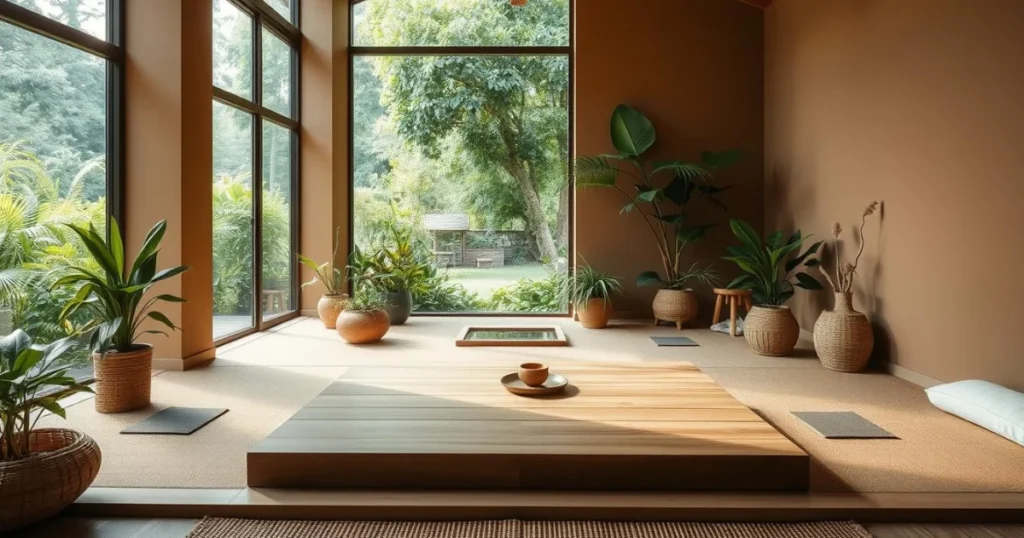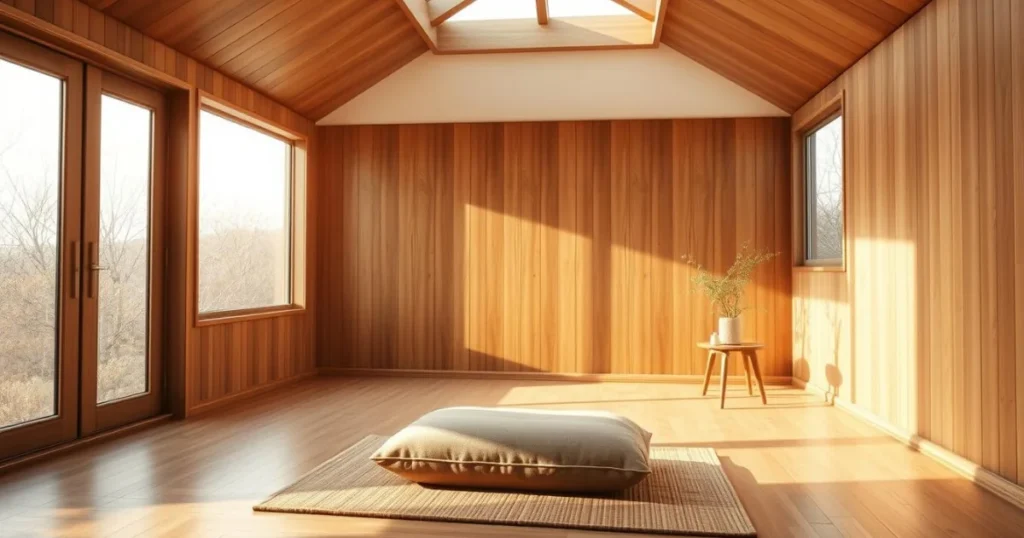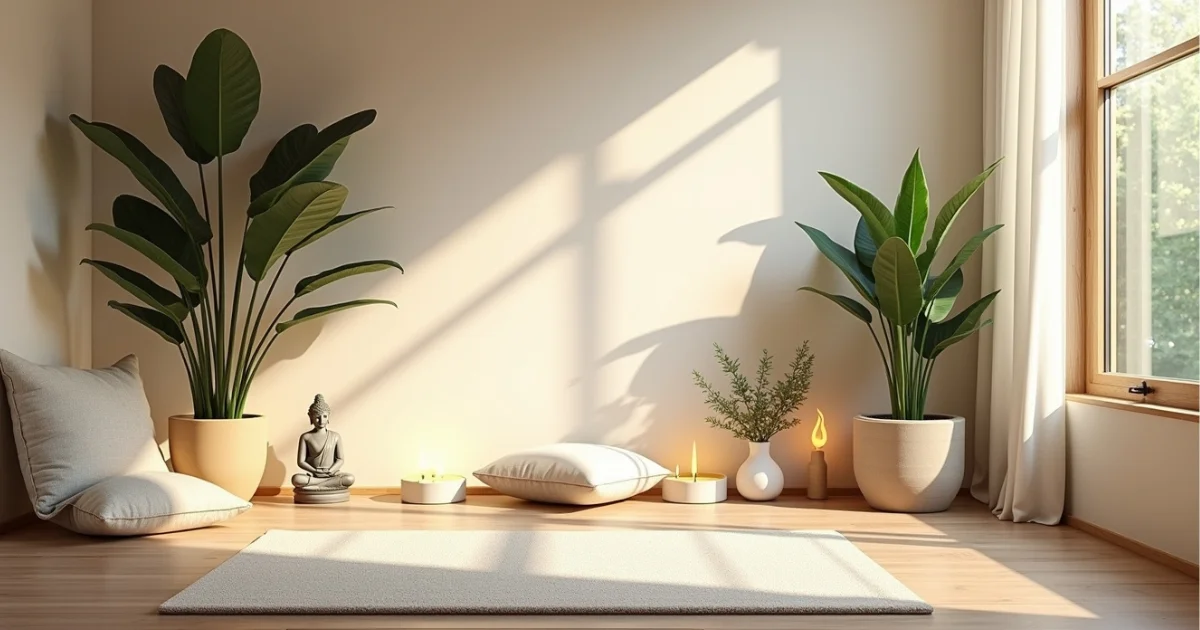Meditation Room: Create the Perfect Space
We’ve lived in a rent-stabilized, four-room apartment in Manhattan for over 30 years. Creating a meditation space has been a great way to find peace in New York City. Our meditation room is a sacred space for calm and focus.
To make it zen, we thought about its purpose, location, and key elements like texture, scent, and lighting. These elements help us create a mindfulness corner that improves our meditation.
Our experience shows that even a small space can become a peaceful retreat. We’ve found meditation rooms in public places, like during a 6-hour layover in Amsterdam. A meditation space can be as small as a corner or a closet spot.
To create the perfect meditation room, we focus on a quiet space, comfy seating, and natural elements like plants and water. These help make our meditation room a true sanctuary for our minds and bodies.
Creating a meditation room can change our anxiety, mood, and stress levels. In just 30 days, we can start feeling meditation’s benefits. With a dedicated space, meditation becomes a continuous practice that changes with our lives.
Table of Contents
Understanding the Purpose of Your Meditation Room
Creating the perfect meditation space is key. It’s not just a tranquil sanctuary; it’s a relaxation area for recharging and refocusing. Having a special room for meditation boosts mental clarity, lowers stress, and brings calm.
A serenity chamber is great for both body and mind. Studies show 76% of people meditate to stay well. A dedicated space helps 70% focus and relax better.
Some main benefits of a meditation room include:
- Improved focus and mental clarity
- Reduced stress and anxiety
- Increased feelings of calm and relaxation
Knowing why we have a meditation room helps us make it a tranquil sanctuary. It’s good for mental health or just a quiet spot. A meditation room is a great addition to any home.
Choosing the Ideal Location in Your Home
Choosing the right spot for a meditation space is key. We aim to make a quiet retreat that helps us focus. It should be away from busy areas and loud noises, creating a calm atmosphere.
A quiet retreat means picking a spot that’s private and quiet. Think about the light, air, and feel of the space. A room with a nice view or lots of natural light can make it peaceful.
Good spots for meditation include a bedroom corner, a cozy living room nook, or a whole room for it. The goal is to make a peaceful oasis where you can relax and meditate. The right spot can boost your mental health and inner peace.
Choosing where to meditate is up to you. What’s right for one might not be for another. But, by considering noise, light, and feel, you can make a quiet retreat for your practice.
Essential Elements of a Meditation Room
Creating a meditation room involves thinking about what makes it special. It’s about comfort and a peaceful vibe. A space for mindfulness should be calm and free from distractions. This means comfy seating, soft lights, and a tidy area.
A meditation room is for unwinding and finding inner peace. Choosing the right seating is key. You might pick a cushion, chair, or bench.
Seating Options and Comfort
Getting the right seat is important for meditation. You can pick from cushions, chairs, or benches. The goal is to find something that lets you sit comfortably for a long time.
Lighting Considerations
Lighting affects the mood of a Mindfulness Space You can use natural or artificial light to set a calm tone. Soft, warm lights help you relax and focus better.
Creating the Perfect Layout
Designing a meditation room is all about creating a tranquil sanctuary. Think about how the space flows and where to place seating and other elements. A good layout lets you move easily and focus on your meditation, making it a deeper experience.
A relaxation area needs to be comfy and calm. Use rugs, throws, meditation cushions, or floor pillows to make it cozy. Adding these elements turns your space into a peaceful place for meditation and relaxation.

The core of your Mindfulness Space should be a serenity chamber. Use natural materials like wood or stone. Add soft textiles and gentle lighting for a calm atmosphere. Designing your room well creates a peaceful
Some important things to think about for the perfect layout include:
- Adding natural elements, like plants or a water feature, to feel connected to nature
- Keeping decor simple to avoid distractions and help focus during meditation
- Having storage for meditation props to keep things organized and easy to find
Color Psychology for Your Meditation Space
Creating a quiet retreat means thinking about color psychology. A peaceful oasis comes from choosing colors that relax and calm. Colors like blue, green, and neutral tones help achieve this.
Studies show blue is the most calming color. It brings relaxation and serenity. Green, symbolizing nature, brings balance and well-being. Neutral colors like white make spaces feel larger and brighter, adding to the calm.
To create harmony, use the 60-30-10 rule. This means 60% of the room is a main color, 30% is a secondary color, and 10% is an accent color.
- Soft blues, such as sky blue or light blue, to promote relaxation
- Muted greens, such as sage green or moss green, to create a sense of balance
- Neutral tones, such as beige or off-white, to create a sense of calmness
Choosing the right colors for your meditation space helps create a quiet retreat. It promotes relaxation and calmness. This helps you find deeper inner peace and connect with your peaceful oasis.
Natural Elements and Biophilic Design
Creating a Mindfulness Space means adding natural elements and biophilic design. This helps us feel connected to nature and relax. It makes our space calm and improves our well-being. To achieve this, we can add plants, natural materials, and water features.
Using natural elements in our meditation room has many benefits. It improves air quality, reduces stress, and boosts our mood. For instance, indoor plants clean the air and make our space healthier. Natural materials like wood and stone add warmth and beauty to our space.
Here are some ways to add natural elements to our Mindfulness Space:
- Add plants, such as fragrant primula or roses, to promote relaxation and reduce physiological stress
- Use natural materials, such as wood or stone, to create a warm and inviting atmosphere
- Incorporate water features, such as a small fountain, to provide a calming auditory and visual experience
- Maximize natural light by placing our meditation room near a window or using mirrors to reflect natural light

By using natural elements and biophilic design, we can make a meditation room that relaxes and reduces stress. As we design our space, let’s focus on these elements. This way, we create a space that nourishes our body and mind, helping us find zen and a perfect mindfulness corner.
Incorporating Sound Elements
Creating a tranquil sanctuary means thinking about sound too. A peaceful space isn’t just about looks; it’s about feeling calm. We can use sound to help us relax and block out distractions.
Using sound-proofing like acoustic panels can make our space quieter. This is key in today’s noisy world. It lets us enjoy calming sounds like nature or soft music.
Some great sounds for our space include:
- Singing bowls and tuning forks for harmony
- Water features for calmness
- Nature sounds for a peaceful feel
Adding these sounds makes our area perfect for meditation or yoga. It’s also great for unwinding. Exploring sound meditation helps us feel clearer and less stressed.
In our sanctuary, we can try different sounds to find what we like. Maybe it’s the sound of waves or a singing bowl. This way, we can make our space truly special. It becomes a calm haven in a busy world.
Conclusion: Creating Your Sacred Space for Inner Peace
Creating the perfect meditation room is a deeply personal journey. It involves thinking about the space’s purpose, picking the right spot, and adding key elements. This way, we can make a quiet retreat that brings us relaxation and peaceful oasis. The best meditation space is one we use often to grow and relax.
Research shows that 60% of people need a quiet place at home for their mental health. Having a dedicated meditation area can help us stick to our practice by 70%. Also, 75% like a quiet room for meditation, and 85% say the space’s feel helps them focus.
By using the tips from this article, we can make a Mindfulness Space that fits our needs. Adding natural elements, choosing soothing colors, and controlling light and temperature are all important. Let’s use this chance to build our own sanctuary of peace and calm.

